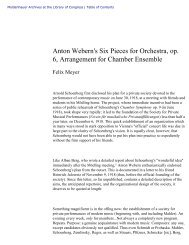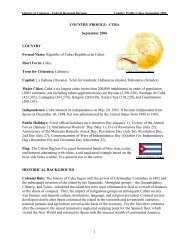1 - American Memory
1 - American Memory
1 - American Memory
You also want an ePaper? Increase the reach of your titles
YUMPU automatically turns print PDFs into web optimized ePapers that Google loves.
240<br />
although airlines continue to function, brings prompt and extensive cancella-<br />
tions of tourists' reseryations for Hawaii.<br />
Purchase of goods by the military forces stationed in Hawaii approximate<br />
$3,000,000 (1954 data) annually. This supply function Is a substantial portion<br />
of the distributive commerce of Hawaii, with more than 800 individual firms<br />
participating in its development. Primary obstacle to increased local procure-<br />
ment is the fear of military commanders that local suppliers will be unable to<br />
carry out their contracts due to unreliable commercial shipping. Since the<br />
military operates its own shipping service (MSTS) local suppliers are by-<br />
passed In favor of West Coast suppliers.<br />
Furthermore, a substantial portion of the local suppliers' normal military<br />
market is lost due to threats of strikes or actual strikes, when the military<br />
transfers its procurement of these Items to the West Coast. This loss of busi-<br />
ness also represents a loss of these cargoes to the <strong>American</strong> merchant marine.<br />
BUSINESS LOSSES AND PAILUKES<br />
All business firms operating within the State have felt the effects of mari-<br />
time strikes and the ever present threat of a strike.<br />
The cost of doing business is normally higher in Hawaii than in the conti-<br />
nental United States, due to the greater distance from supply and market cen-<br />
ters. However, unreliable shipping has Increased these costs with requirements<br />
for larger protective inventories and substantial transshipment and shortage<br />
costs for strike bound cargoes.<br />
During the 63-day Pacific maritime strike of 1952, the Hawaiian sugar in-<br />
dustry estimated direct increased costs, through such factors as emergency stor-<br />
age and refinery shutdown, at $1,785,000. This is, of course, a small part of the<br />
total indirect cosrt through loss of markets, employment and other factors.<br />
Dairy, hog and poultry farmers have suffered severely from feed shortages and<br />
have been forced to kill off i>art of their livestock. Both large and small farming<br />
have been hard hit by recurrent insecticide and fertilizer shortages.<br />
Many small business failures in Hawaii can be directly attributetl to shipping<br />
stoppages. Unable to secure inventories, and with working capital depleted, these<br />
firms have been forced out of business.<br />
These and other adverse effects on business enterprises, resulting partially<br />
from the unreliability of shipping, have contributed to low corporate income<br />
in Hawaii, a decline In local stock transactions, the tightening of bank credit,<br />
a shortage in venture capital and a moderate out migration in post-war<br />
population.<br />
EFFECTS OF THREATENED STRIKES ALSO SEVERE<br />
The effect of strikes i.s clearly set forth in "The liconomy of Hawaii in 1947"'<br />
as follows:<br />
"The economy of Hawaii is much more susceptible to . . . 'shipping stoppages'<br />
than a mainland community of similar size would be. The extreme vulnerability<br />
of the island economy was clearly demonstrated in the spring of 1947 when<br />
... a shipping strike (was threatened) in June. As early as April, business firms<br />
began to cancel their advance orders for merchandise from the mainland. This<br />
was due to the fact that, during the strike in the autumn of 1946, merchandis«»<br />
delivered to West Coast docks for shipment to Hawaii remained there durint;<br />
the strike while the purcliasers were billed for the Invoiced goods which they<br />
could not sell. New l)usineBS firms and small firms could not afford to pay for<br />
merchandise not actuallj- in physical inventory and, rather than run the risk<br />
of l>ankruptcy, they cancelled orders. This later resultetl in a loss of sales on<br />
such merchandise and created shortages of various types of consumer gooi*".<br />
in the Territory.<br />
"As soon as the shii>ping strike was threatened in 1947, practically all of the<br />
construction contracts that were in negotiation wen? postponed and even cor-<br />
stnictioii wliich was to start in April or May was held up because neither the<br />
owner nor the contractor wished to assume the risk of starting projects when<br />
there was no reasonable assurance that the materials for completing them<br />
could lie obtained.<br />
' Extract from "The EUronoroy of Hawaii In 1947." by James H. Shoemaker: nn 1R6.<br />
Bulletin No. 026 U.S. Department of Labor, transmitted to Confess Jan. 2», 1948.



![Albert Einstein Papers [finding aid]. Library of Congress. [PDF ...](https://img.yumpu.com/21604228/1/190x245/albert-einstein-papers-finding-aid-library-of-congress-pdf-.jpg?quality=85)





![American Colony in Jerusalem Collection [finding aid]. Library of ...](https://img.yumpu.com/17941275/1/190x245/american-colony-in-jerusalem-collection-finding-aid-library-of-.jpg?quality=85)



![Piccard Family Papers [finding aid]. - American Memory - Library of ...](https://img.yumpu.com/17941234/1/190x245/piccard-family-papers-finding-aid-american-memory-library-of-.jpg?quality=85)


